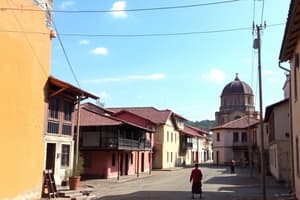Podcast
Questions and Answers
What is the primary focus of the science of history?
What is the primary focus of the science of history?
- The study of natural phenomena
- The study of human society from its origins to the present (correct)
- The study of animal behavior
- The study of astronomy
What type of sources are documents written by historians and other professionals?
What type of sources are documents written by historians and other professionals?
- Quaternary sources
- Primary sources
- Secondary sources (correct)
- Tertiary sources
Which of the following sciences is concerned with the study of the Earth's physical features and human relationships with the environment?
Which of the following sciences is concerned with the study of the Earth's physical features and human relationships with the environment?
- Geography (correct)
- Archeology
- Numismatics
- Cartography
During which period of the Stone Age did humans learn to make fire?
During which period of the Stone Age did humans learn to make fire?
What was the primary metal used during the Copper Age?
What was the primary metal used during the Copper Age?
Which theory of human origins is based on religious doctrine?
Which theory of human origins is based on religious doctrine?
What was the primary characteristic of Homo habilis?
What was the primary characteristic of Homo habilis?
What type of sources are photographs, films, and television recordings?
What type of sources are photographs, films, and television recordings?
Flashcards are hidden until you start studying
Study Notes
What is History?
- History is a science that studies human society from its origin to the present day.
Sources of History
- Primary sources:
- Written: newspapers, letters, laws
- Oral: myths, legends, songs
- Material: constructions, ceramics, weapons
- Audiovisual: films, photographs, TV
- Graphic: drawings, paintings
- Secondary sources: documents elaborated by historians and professionals, including biographies, theses, and books.
Auxiliary Sciences of History
- Archaeology: explores material remains of the past.
- Geography: studies the relationship between humans and the natural environment.
- Numismatics: studies coins and medals.
- Paleontology: analyzes fossil remains of living beings.
- Cartography: specializes in the representation of geographical spaces.
Stages of Prehistory
Edad de Piedra (Stone Age)
- Paleolithic (2.5 million - 10,000 BCE)
- Nomadic lifestyle, living from hunting, fishing, and gathering
- Learning to make fire
- Cave art
- Mesolithic (10,000 - 6,000 BCE)
- Beginning of pottery
- Use of hooks, nets, and canoes
- Funeral rituals
- Neolithic (6,000 BCE)
- Emergence of agriculture
- Emergence of livestock
- First cities
Edad de los Metales (Age of Metals)
- Copper (first used metal)
- Worked cold
- Beginning of metallurgy
- Bronze (copper and tin combination)
- Started siderurgy
- More resistant metal
- Iron (most used metal)
- Most resistant
- Produced agricultural tools and weapons
Theories of Human Origins
- Creationist Theory: based on religious doctrine
- Evolutionist Theory: explains human evolution through scientific research
Characteristics of Human Species
- Homo Habilis:
- Nicknamed "handy man"
- Made stone tools
- Ate seeds
- Homo Erectus:
- Nicknamed "upright man"
- Discovered fire
- Used animal skins for clothing
- Homo Sapiens:
- Nicknamed "thinking man"
- Expert hunter
- Performed religious rituals
- Homo Sapiens Sapiens:
- Nicknamed "wise rational man"
- Decorated caves with drawings
- Used language
Studying That Suits You
Use AI to generate personalized quizzes and flashcards to suit your learning preferences.




